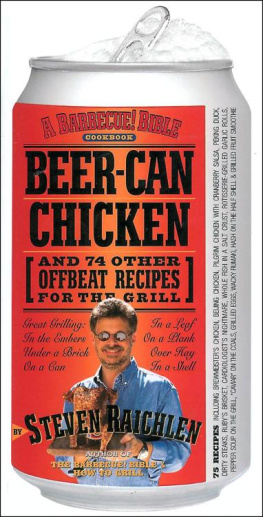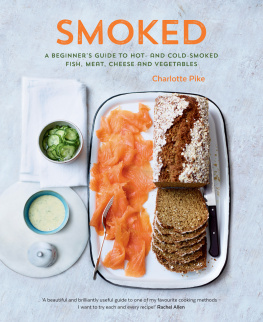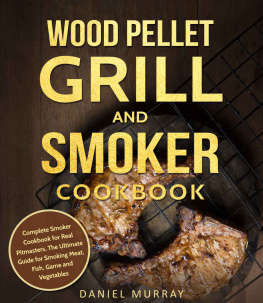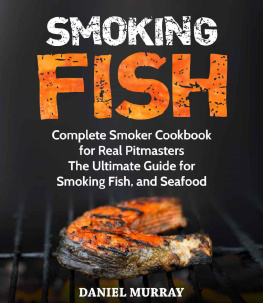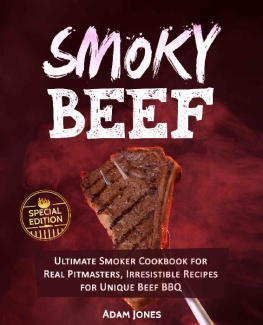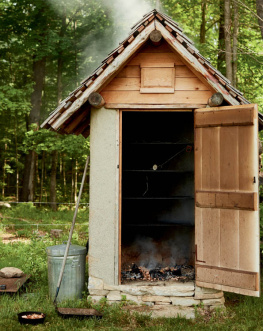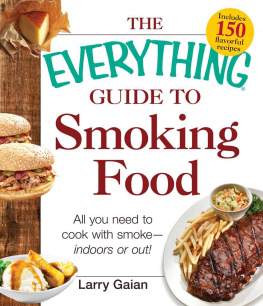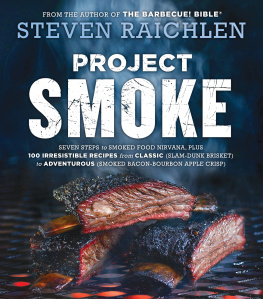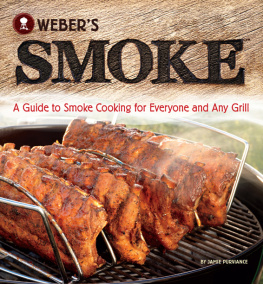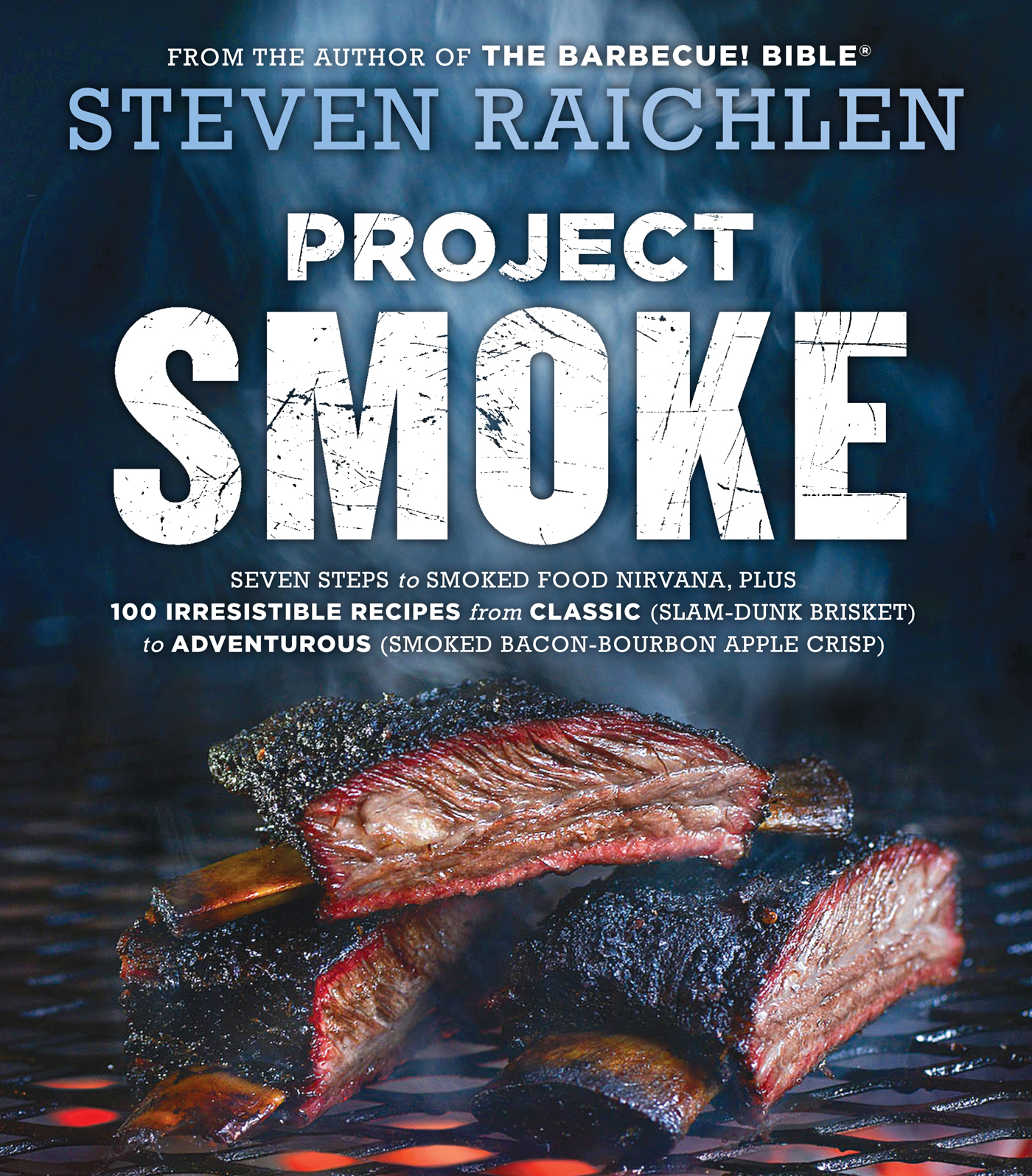Project Smoke
Seven Steps to Smoked Food Nirvana, Plus 100 Irresistible Recipes from Classic (Slam-Dunk Brisket) to Adventurous (Smoked Bacon-Bourbon Apple Crisp)
Steven Raichlen
Workman Publishing
New York
To Ella, Mia, and Julian, who light my fire.
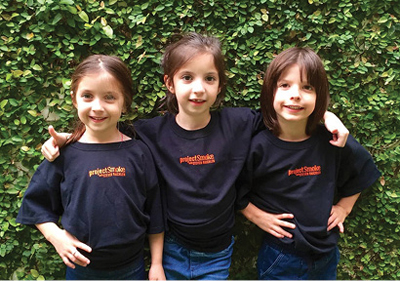
Acknowledgments
It gives me great pleasure to thank all the people on team Project Smoke.
Editorial and Production: Sarah Brady, Kate Karol, Suzanne Fass, Barbara Peragine, and Claire McKean
Design: Becky Terhune
Photography: Anne Kerman, Matthew Benson, Nora Singley, Sara Abalan, Bobby Walsh, Angela Cherry, and Lena Diaz
Publicity and Marketing: Selina Meere, Rebecca Carlisle, Jessica Wiener, and Lauren Southard
Sales: All the members of the great Workman sales team
Website: Molly Kay Upton and Joanna Eng
Recipe Testers: Rob Baas, Chris Lynch, Denise Swidey, and Ashley Archibald
Project Smoke TV: Matt Cohen, Gwenn Williams, Richard Dallett, Ryan Kollmorgan, John Pappalardo, Patrick Shea, Jillian Kuchman, Michael Orsborn, Jon Nichols, Paul Stapleton-Smith, Emily Belleranti, Michael Cottrel, and John Dietz
Maryland Public Television: Steven Schupak, Jay Parikh, Stuart Kazanow, Frank Batavick, and Donna Hunt
Additional Support: Chuck Adams, Ron Cooper, Sam Edwards, Ole Hansen, Patrick Martini, Matthias Messner, Helle Mogenson, and Nathan Myhrvold
Gear: All-Clad, BBQ Guru, Big Green Egg, Bradley Smoker, Camerons Products, Carolina Cookwood, Hasty-Bake, Horizon Smokers, Kalamazoo Outdoor Gourmet, Kai USA, Ltd. (Shun Cutlery), Kamodo Kamados, Kingsford, Landmann, Lodge Manufacturing, Maverick Housewares, Memphis Wood Fire Grills, Nordic Ware, Weber, The Pit Barrel Cooker Co., Polyscience, Royal Oak, Smoke Daddy, Spitjack, ThermoWorks, and Yoder Smokers
Food Companies: Alaskan Seafood Marketing Institute, The Green Grape Provisions, Heritage Foods USA, Melissas, Strauss Brands, Tecumseh Farms, and Trivento
Finally, a huge Project Smoke thanks to my indefatigable assistant, Nancy Loseke, my extraordinary editor, Suzanne Rafer, and my amazing wife Barbara, whos behind all the good things that happen in my life.
Contents

Introduction
A Crash Course in smoking
T here are many places I could start this book. On Bornholm, Denmark, where at the height of the smoked herring industry in the 1930s, this small island in the Baltic Sea boasted more than 120 active smokehouses, their whitewashed brick chimneys still punctuating the landscape today.
Or in the Italian Alps, where salt-cured hams are smoked with juniper wood for two weeks to make a smoky prosciutto called speck. A similar scene takes place in Surrey, Virginia, where the Edwards family has been smoking hams since 1926.
Or on Islay Island in Scotland, where barley is smoked over peat to make Scotch whisky, or on the rugged hillsides around Oaxaca, Mexico, where agave cactus hearts are smoke-roasted in fire pits to prepare a unique smoky spirit called mezcal.
Or closer to home, at the American Royal World Series of Barbecue in Kansas City, where for three days and nights, barbecue teams from all over the worldmore than 600gather to compete, sending fragrant clouds of wood smoke over Arrowhead Stadium.
But the best place to begin might be my backyard, where as I write these words, salmon, scallops, and beef jerkynot to mention ricotta, mustard, and hot sauceare smoking in a cedar smokehouse I built with my neighbor Roger Becker.
Smoke. Few words have such power to make you hungry. Think of some of the worlds most pleasurable foods: ham, bacon, pastrami. All owe their distinctive flavor and character to smoke.
Smoke is the subject of this book. Hot-smoked foods like kippers and ham. Cold-smoked foods like mozzarella affumicata and Scandinavian lax. American barbecue, from Texas brisket to Carolina pulled pork to Kansas City ribs. Smoked foods from around Planet Barbecue like Jamaican jerk chicken and Chinese tea-smoked duck.
So you might ask: How does this book differ from all my other Barbecue! Bible cookbooks? While its true that most of my books touch on smoking, particularly as practiced in the American barbecue belt, this book focuses exclusively on smokefrom smoked meats and seafood to smoked cocktails, condiments, and desserts. Youll learn how to smoke the icons and the foods youd never dream of smoking, including cheesecake, ice cream, mayonnaise, butter, and ice.
So fire up your smokers. Project Smoke is about to begin.
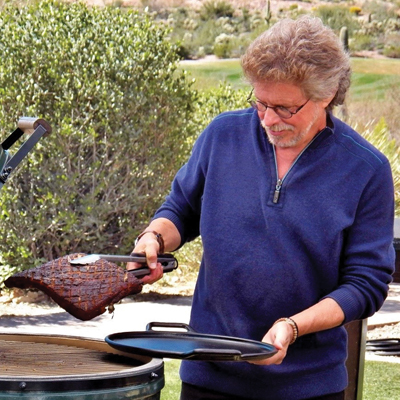
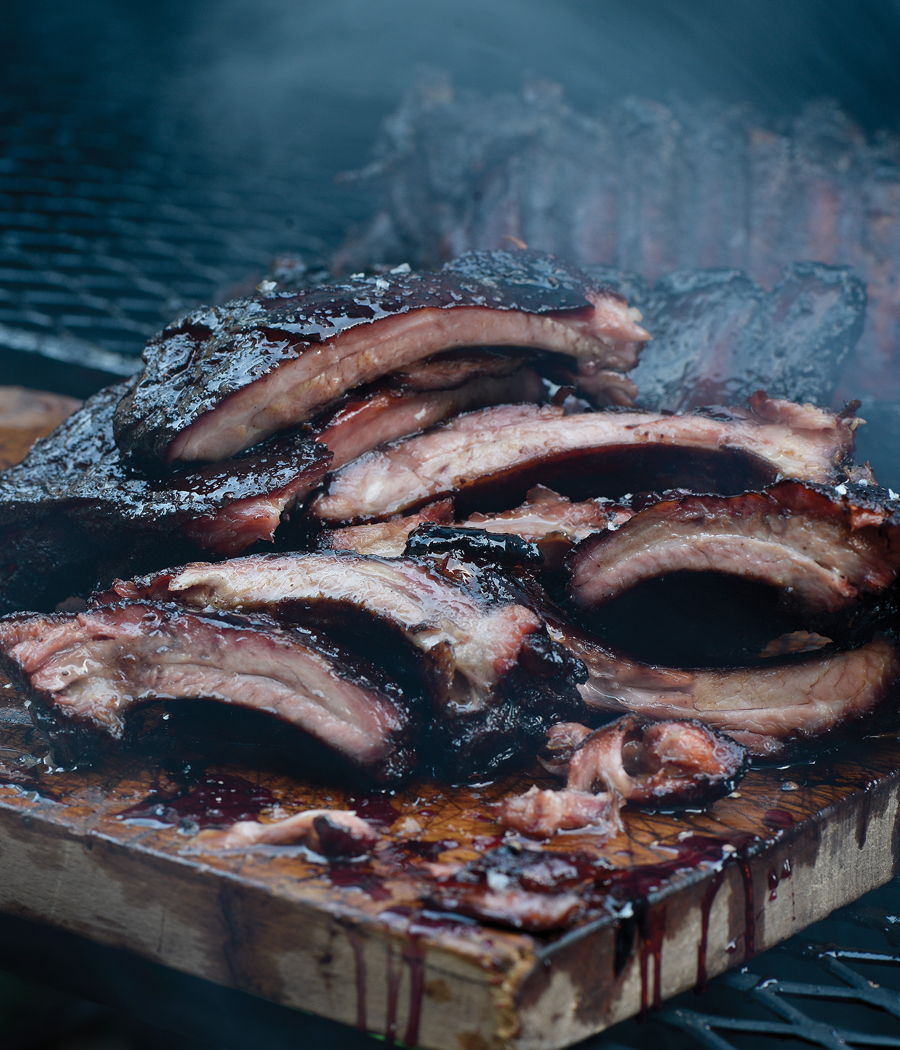
The Seven Steps to Smoking Nirvana
S moking is easy but it isnt always simple. There are hundreds of smokers to choose from and each type operates differently. You can spend a few hundred dollars on a smokeror thousandsand the price doesnt always predict performance.
Then theres the wood: hickory, oak, apple, or mesquite, to mention just a few of the dozens of fuels used for smoking. Each has its partisans, and thats before you start talking green or seasoned; dry or soaked; logs, chunks, chips, or pellets.
Next come the meats: prime or choice; organic or heritage; not to mention seafood (wild or farmed, whole or filleted), vegetables, cheese, eggs, and desserts.
And once you build your firebelieve me, theres a lot of debate about the best way to do thatyou have to choose the smoking method: hot-smoking or cold-smoking; smoke-roasting or with a handheld smoker. How long the various foods smoke and how you know theyre done.
Does it sound complicated? It is (a little), but Ive broken the process into seven easy steps. Follow them and youll master smoking in no time, and youll have a lot of funand satisfactionin the process.
Step 1
Choose Your Smoker
Your first step is to select the right smoker for you. There are dozens of types and hundreds of individual models. So read this section and The Various Types of Smokers .
The right smoker for you depends on your experience, goals, and how many people you usually cook forcollectively called your smoker personality.
Beginner: You want a smoker thats affordable and easy to operate, and that doesnt take up a lot of space. Good bets include: a kettle-style charcoal grill or other grill with a tall lid; a water smoker; a ceramic cooker; and an upright barrel smoker.
Grilling enthusiast who wants to explore smoking: Grilling is your first love, but you want to do smoking, too. Check out a kettle grill or front-loading charcoal grill; a wood-burning grill; a ceramic cooker; or an offset smoker with a firebox that comes with a grate.
Convenience- and results-oriented smoker: You love smoked and barbecued foods, but want the push-button convenience of a gas grill. Consider electric or gas smokers or pellet grills.
Process-oriented smoker: You embrace not just the results, but the process of smokingbuilding and maintaining a fire, adjusting the air vents, and so on. A water smoker or an offset smoker would be right for you.


